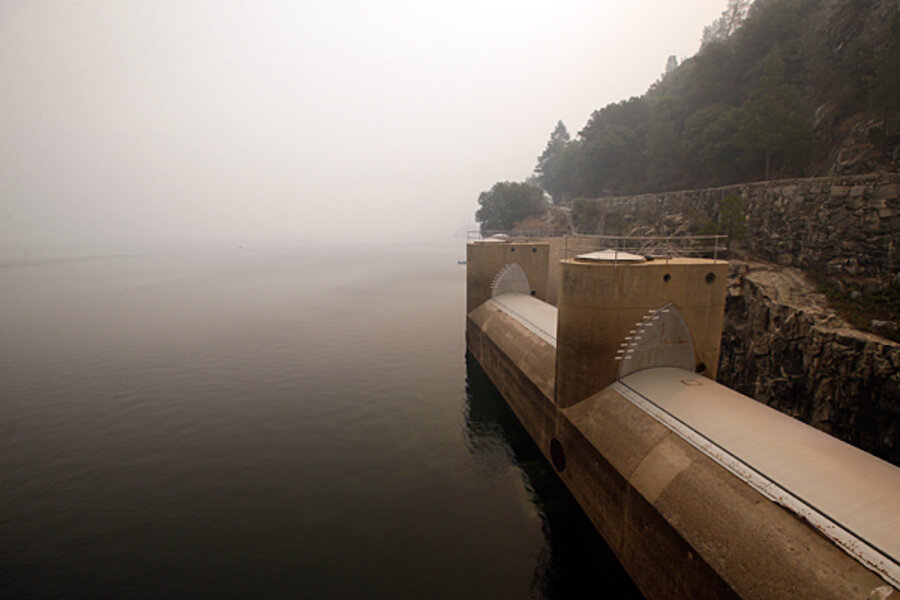Rim Fire near Yosemite: Threat to San Francisco water supply not over
Loading...
| Los Angeles
Flames from northern California's Rim Fire – now the size of Chicago, at 234 square miles – came within one mile of the reservoir that supplies 85 percent of San Francisco's water, and water authorities have been racing to fill local water basins before ash reaches intake pumps far below the surface.
For the time being, the iconic Yosemite Valley and stands of giant sequoia appear safe, with the fire licking the fringes of Yosemite National Park. But the continuing threat to the Hetch Hetchy Reservoir underscores the unusually high stakes surrounding the firefighting effort.
“The challenges that the Rim Fire poses for firefighters, and the citizens of San Francisco, are exponentially greater than [with] a typical wilderness fire,” says firefighting expert Char Miller, a professor of environmental analysis at Pomona College in Claremont, Calif. “There can be no mistakes; there is no room for error. The fire ought to make it crystal clear to San Franciscans how critical the Sierras are to their daily life.”
Containment of the fire, which began Aug. 17, had doubled to 15 percent by 11:30 a.m. Monday Pacific time. But some of Yosemite’s backcountry hiking trails have been closed, 23 structures have been destroyed, and 4,500 more are threatened. Four thousand firefighters are assigned to the blaze, with winds hitting 30 miles per hour in an area of difficult and steep terrain that makes movement on the ground arduous.
San Francisco officials say no contamination has occurred of the water supply from Hetch Hetchy, which is renowned for its purity. Some 260 million gallons of Hetch Hetchy water flow 160 miles west, downhill through pipes leading to San Francisco. If the water becomes too turbid – too polluted by particulates from the fire – San Francisco could draw emergency waters from other reservoirs. The turbidity of Hetch Hetchy water is only 0.2 now, Charles Sheehan, a spokesman for the San Francisco Public Utilities Commission, told USA Today. The emergency threshold is 5.0.
But some experts suggest the threats to water supply could continue after the fire is out, as ash is washed into rivers, lakes, and reservoirs.
“After the burn, heavy rains can cause mass movement of charcoal, ash, and sediments – how much depends on the severity of the burn and the magnitude of the rains,” says Stephen Pyne, a professor of life sciences at Arizona State University who is completing two books on the past 50 years of American fire management. “In natural systems, the effects wash out after a year or two, but I don't know what happens with a reservoir.”
The other threat posed by the Rim Fire is damage to hydroelectric power generated by the reservoir's dam. Two of the facility's three powerhouses have been closed because of fire damage, and about a dozen miles of power lines have been lost, Mr. Sheehan said. The San Francisco Public Utilities Commission has had to spend $600,000 for power on the open market to make up for the losses.
The fires have already led Gov. Jerry Brown to declare a state of emergency for San Francisco, and fire experts say the situation shows why San Francisco must pay more heed to fire management in the Sierras.
The city's "wealth should be in part directed to help the [US] Forest Service and [National] Park Service make for more defensible space around this critical urban infrastructure," says Professor Miller.
Firefighters are currently building up fire defenses around sequoias. The giant plume of smoke from the fire is creating shade, which cools the air temperature, and crews are using sprinklers and igniting brush to clear it while the fire is still several miles away.
Some in the public have speculated that fighting sequoias on fire must be more dangerous because of their size, but Miller is not sure.
“A tree in full flame is dangerous regardless of size and age,” he says. "Defending the ancient woods in and around Yosemite because these are the iconic trees is a cultural dilemma, not a firefighting one. We cannot argue that fire is essential to some ecosystems such as this, and then turn around and claim that we are going to stop fire from destroying some groves and not others because some groves are inside a park boundary. But in fact that is the calculation being made, and that makes the firefighters' job that more complex.”







